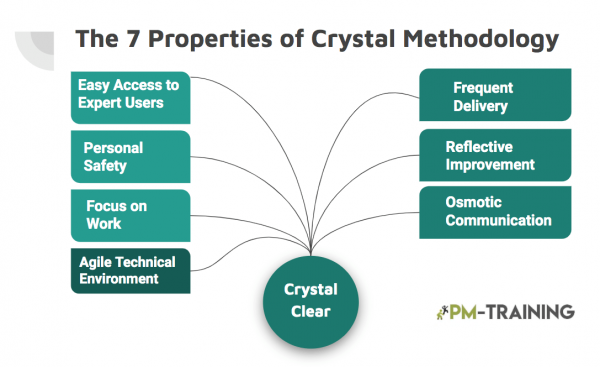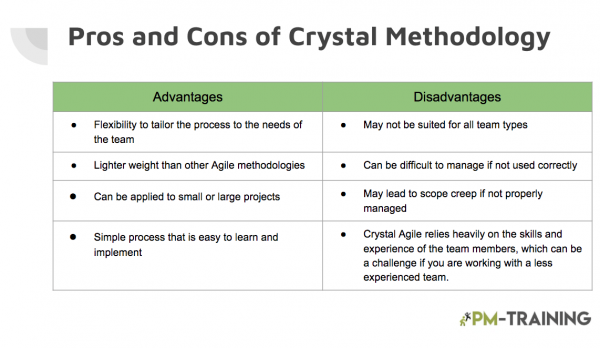Crystal is a family of agile software development methodologies invented by Alistair Cockburn. The methodology is based on the experiences of software developers who have found success using agile development practices. It is characterized by specific values, guidelines, and properties that distinguish it from other agile frameworks.
Crystal is a family of Agile software development methodologies characterized by high levels of developer communication and collaboration, frequent “releases” in short development cycles, and a preference for working in an informal, co-located environment.
The crystal agile methodology approach was first proposed in Alistair Cockburn’s 1997 book, Crystal Clear: A Human-Powered Methodology for Small Teams. It has since been adapted and extended to work in a wide range of environments, from very small teams to very large organizations.
The crystal agile methodology has been proven to be effective in a variety of software development projects, ranging from small-scale applications to large-scale enterprise systems.
Crystal is not a single, prescriptive approach, but rather a set of guidelines that can be tailored to the needs of any project.
The main goal of the crystal agile framework is to help developers effectively solve complex problems in an ever-changing environment.
Principles of Crystal Methodology
The Agile Crystal methodology has been shown to be effective in delivering software that meets the needs of users.
The methodology is based on four key values:
- People
- Communication
- Simplicity
- Feedback
This methodology is an approach to software development that values human communication, collaboration, and collective intelligence over processes and tools.
As it was created in order to address the shortcomings of traditional approaches to software development.
The seven properties of Agile Crystal are:

- Frequent delivery
- Delivery not iteration
- Every two months
- Min 2 deliveries per project
- Reflective improvement
- Improve Methodology
- Improve the team
- Reflection Workshop
- Osmotic communication
- Improve the team
- Sit Close
- Communicate often
- Personal safety
- If you are scared you don’t perform
- When you feel safe you can critique
- Focus on work
- Minimize Disruption
- Loud & quiet time
- Access to subject matter experts and users
- Written Specs are not enough
- Feedback early
- Feedback often
- Real user, not your manager
- Technical tooling
- Automated Test
- Configuration Management
- Frequent Integration
Each one takes into account the following aspects in order to
- Work closely with the customer to understand their needs and requirements for a constant delivery
- Develop the software incrementally, delivering new functionality to the customer as soon as it is ready this allows the product for an accelerate improvement
- Encourage collaboration and teamwork among all members of the development team
- Allow for adaptability and change throughout the software development process
- Continuously improve the process and the software product
- Close, daily cooperation between business people and developers
- Projects are built around motivated individuals, who should be trusted
- A face-to-face conversation is the best form of communication (co-location)
- Working software is the primary measure of progress
- Sustainable development, able to maintain a constant pace
- Continuous attention to technical excellence and good design
- Simplicity–the art of maximizing the amount of work not done–is essential
- Best architectures, requirements, and designs emerge from self-organizing teams
Colour families and their function
The Crystal family of agile methodologies includes:
Crystal Clear
It is the original methodology in the family, a lightweight methodology designed for small teams working on small projects. It consists of small teams of 1-6 people.
Crystal Yellow:
It is a variation of Crystal Clear that is geared towards larger projects as a methodology that adds techniques for managing risk and uncertainty to the Crystal Clear framework. The team size in this one can be between 7-20.
Crystal Orange:
A methodology that adds techniques for concurrent engineering and constant change to the Crystal Yellow framework as required by consistent user feedback. Teams in Crystal Orange can be between 21- 40
Crystal Red:
A methodology designed for teams working in highly regulated environments. Mainly focused on hardening sprints following a more traditional software development approach. The team sizes can be between 40-80
Crystal Maroon:
This is for large projects with 80-200 people where the software requirements determine the approaches to be employed.
Crystal Diamond or Sapphire:
It is considered to be one of the most critical ones for more than 200 people for large projects where even human life can be exposed to danger.

What are the pros and Cons of Crystal Agile Methodology?
There are many benefits to using Crystal Agile methodology, including its focus on teamwork, its clear guidelines and structure, and its emphasis on customer satisfaction.
However, there are also some potential drawbacks to using the crystal agile methodology, such as its inflexibility and its reliance on strict adherence to the guidelines.

Ultimately, whether or not Crystal Agile methodology is right for your software development project depends on your specific needs and goals.
If you are looking for a fast, efficient, and high-quality software development process, then Crystal Agile methodology may be a good fit for
What is Crystal Agile Methodology?
Crystal Agile methodology is a set of software development guidelines that aim to improve the speed, quality, and efficiency of the software development process. It is based on the principles of Crystal Clear, an Agile methodology developed by Alistair Cockburn in the early 2000s.
What are the differences between Agile Crystal and Scrum Methods?
Agile is a more general approach that can be adapted to any project, while Scrum is a more specific methodology that is designed for software development projects. The main difference between Agile and Scrum is in the team size. Agile can be used with teams of any size, while Scrum is designed for small teams of no more than 9 members.
What are the three concepts followed in Crystal Methodology?
The three main concepts in the Crystal agile methodology correspond to team size, criticality, and the priority of the project.
